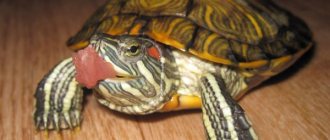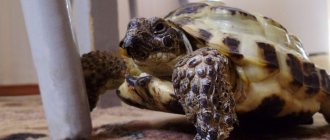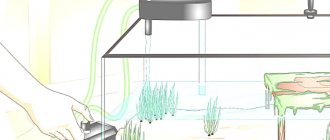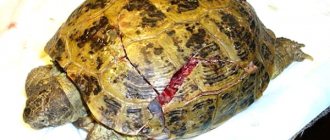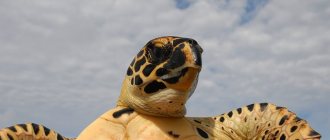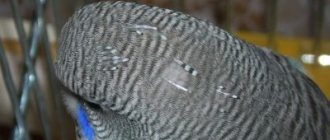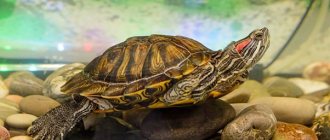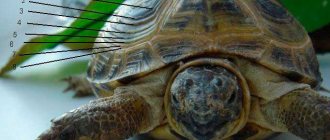Since childhood, we have associated the image of a turtle with two of the cutest representatives of this type of reptile - Tortila with her golden key and the Turtle, who in the famous cartoon sang a duet with the Lion Cub a song about “I’m lying in the sun...”
Maybe that's why these exotic animals are readily kept as pets. Children especially love them. Turtles have an extremely calm, accommodating disposition, and their appearance is quite attractive. They do not require special care.
However, like any living creature, problems may arise that will cause panic among the owners of the “tortillas”. In particular, they can be so connected with the shell that they can tell a lot about the state of health of the reptile.
Pond slider
The taxonomy of the red-eared turtle species is very confusing. Their shell is relatively flat. The young of these reptiles have a light green tint to their shell; with age, its color changes to light brown or olive, then patterns appear on it that look like vertical yellow stripes, which are especially noticeable in water. Behind the eye of the red-eared turtle there is an elongated red spot. It is thanks to him that it owes its name. Stripes of white and light green colors are observed on the head, neck and limbs of the reptile.
Detachment of horny plates
This trouble is not a disease, but rather a consequence of various reasons. Some doctors consider this phenomenon as a symptom.
In normal condition, turtles' shells do not peel off and molting does not occur. But during the period of growth of the horny plates, this phenomenon occurs quite often. In adulthood, this can occur due to a lack of vitamins A and B2, improper content, the appearance of fungus or the influence of harmful algae.
If the shield comes off smoothly, then there is no need to worry.
In other situations, you should act accordingly:
- The shield is increased in size and extends only from the middle. This problem can be solved with increased feeding and vitamin replenishment. There is no harm in adding methylene blue to the water.
- The shield is divided into layers, inside it there are entire cavities. In the place where the shield was, a gray coating or brown crust remains. This is a consequence of the activity of the fungus. To get rid of it, you need to completely clean the aquarium, place the turtle separately and soak it in oak bark tincture. In addition to this, you need to add methylene blue to the main water. In any situation, treatment should last 2 weeks.
- The scutes come off only in a specific place, a softening of the healthy scutes is felt around, and an ulcer or blood remains at the place where they are located. This is a bacterial disease. In this situation, bluing will again come to the rescue, as well as clotrimazole ointment, and a complex of antifungal drugs. The turtle should be left in a dry place at night. It's better to consult a veterinarian.
Diseases in which the skin peels off
It is normal for a reptile's skin to peel and flake off during the molting period. As soon as the animal is raised, everything is over.
But sometimes peeling skin can be a sign of pathology.
The clinical picture of the following diseases resembles the molting process:
- Mycosis. Most often, a fungal infection develops in the spring, when the animal’s immunity is weakened, especially if it hibernated. With this disease, you can notice a white coating on the skin, which can be easily removed with a cotton swab. If the animal moves and touches various objects, then white stripes remain on them.
- Rickets. With this pathology, the shell becomes bent and may begin to peel off. The eyes may become swollen, causing them to close completely. Due to the curvature of the jaws, the turtle does not eat anything, which can cause death.
- Hypovitaminosis. If an animal’s diet is monotonous and it does not receive all the necessary vitamins, then it may develop vitamin deficiency. Hypovitaminosis A is manifested by peeling of the skin. There is desquamation of large scutes on the limbs and head, marginal blepharitis, in which the eyelids swell, and the cloaca prolapses. The reptile grows a “parrot-like” beak. Often, with hypovitaminosis A, a runny nose is observed, so the disease is confused with a bacterial infection. Also, the animal may not eat anything, which will cause the reptile to become exhausted. To prevent the development of vitamin A deficiency, the pet must constantly receive liver, fish entrails, carrots, and pumpkin.
To exclude these pathologies, it is advisable to show your pet to a herpetologist, who, if necessary, will select adequate therapy.
If this is not possible, then you should carefully examine the reptile. When the animal is active and does not exhibit any alarming symptoms, then most likely the peeling and detachment of the skin is associated with molting and there is no cause for concern. This means that the red-eared slider is developing correctly.
How red-eared turtles molt
Prevention measures
Any disease is easier to prevent than to treat. Turtle shell problems are no exception. To avoid them, provide your reptile with adequate nutrition. The menu should consist of food of animal and plant origin.
Buy a UV lamp and give your turtle irradiation sessions to produce vitamin D in its body, which facilitates the absorption of calcium. In summer, take your turtle outside for walks. At the same time, make sure that the animal does not come into direct sunlight.
Pay attention to the water you fill the aquarium with. Its excessive rigidity can negatively affect the condition of the shell. This water must be filtered.
In addition, tap water contains chlorine, which causes certain diseases. Let it sit for a day before pouring it into the aquarium so that the harmful impurity has time to evaporate.
Pathological causes of soft shell
The dorsal shield of the shell in babies is bright green. With age, its color becomes darker, olive green. You can see black and yellow stripes on it. The ventral shield is dark in color and has black spots on it. These age spots on the red-eared slider's shell are a variant of the norm. At the same time, the shell is hard to the touch.
When it becomes soft and its separation is observed in an adult reptile, this is a symptom of pathology.
Often, a reptile has not only a soft shell, but a number of other signs:
- redness and swelling of the eyes;
- heat;
- the edges of the shell bend, its particles begin to peel off.
Such signs can be observed in various pathologies: dysfunction of the thyroid gland and intestines. The hardness of the shell depends on the amount of calcium in the reptile's body. The lack of this mineral causes the pyramidality of the carapace and a number of other signs and the development of rickets. The structure of the skull bones is disrupted, as a result the reptile cannot eat.
A lack of calcium in the body can be caused by dysfunction of the intestines and kidneys, which causes a deterioration in the absorption of the mineral. A deficiency of UV rays leads to a lack of vitamin D, which can also cause softness and peeling of the carapace tissue.
If your pet's shell peels off, this may be a sign of mycosis. With a fungal infection, a white coating may be observed on the shell of the red-eared turtle. White stripes can also remain on objects that the reptile rubs against. Also, when there is a fungal infection, the red-eared turtle scratches its shell.
In addition, white spots on the shell of a red-eared turtle can be observed if:
- the water in the aquarium is hard;
- improper feeding of the turtle;
- shell injuries;
- incorrect lighting.
Soft shells, bruises and an unpleasant odor can be observed due to burns and trauma to the shell, which are complicated by a secondary bacterial infection. In this case, the pet is treated with antibiotics.
If the reptile looks sick, you need to show it to a herpetologist as soon as possible, who will determine why the shell of the red-eared turtle is peeling off, it has become soft and will tell you what to do and how to help the animal.
If the vet is out of reach...
Fungus
Having noticed that the turtle has begun to molt, the owner should examine it and observe carefully. If, in addition to detachment, no other deviations from the norm are identified, the animal behaves actively, there is no reason for concern.
Having discovered that the shell is peeling off very much and even crumbling, you should resort to special treatment, which is prescribed based on the diagnosis. (The symptoms of various “shell troubles” were discussed above).
Pharmacies sell antifungal drugs Nizoral or Lamisil. They should be used to lubricate the damaged areas of the shell at night for two weeks, having first very carefully cleaned off the exfoliated tissue.
The fungus can cause irreversible degeneration in the tissues of the turtle “armor”. Such tissues must be carefully cleaned and BetaisodonaR ointment applied to the ulcerated area.
In the case of a fungal disease, “therapeutic baths” are recommended for the amphibian - bathing in chamomile decoction, a weak solution of potassium permanganate or malachite greens. The latter, by the way, is used to disinfect aquarium water.
The disease in its unadvanced stage can be treated quite successfully. If the fungus reaches the internal organs, it can cause the death of the animal.
The shell of a land turtle can peel off as a result of dehydration. In this case, daily bathing of the animal is recommended.
As for rickets, which, as we found out, is the result of a deficiency of vitamin D and calcium, here we are most likely talking not so much about the treatment of the disease, but about its prevention.
In the autumn-winter period, turn on the UV lamp.
So, in the warm season, it is recommended to take the aquaterrarium with the turtle out into the fresh air, while protecting the reptile from direct rays of the daylight.
In the autumn-winter period, the dwelling with the amphibian must be placed under a UV lamp three times a week - literally for five minutes.
Before the procedure, it is recommended to cover the turtle’s eyes with a plaster so as not to harm the lens and retina.
To replenish the level of calcium in the reptile’s body, shrimp rich in this element will not be superfluous in its menu. Since this pleasure is not cheap, you can treat your pet with fish and bones instead. Bone meal, crushed egg shells, and chalk are very useful.
If the disease is advanced, the veterinarian, as already mentioned, will prescribe vitamin injections.
It's easier to warn...
Spots on the shell.
And a few more “preventive” tips.
Proper feeding is largely the key to turtle health. This reptile should have both animal and plant food on the “dining table”. Exclusively meat products on the menu can provoke the occurrence of vitamin A deficiency and rickets. The turtle's diet should be varied: vegetables and fish, fruits and berries.
Spots on a turtle's shell can appear due to excessively hard water, so before adding it to the aquarium, the liquid must be carefully filtered.
In addition, tap water is often disinfected with chlorine, which can also cause a number of diseases. The water in the aquarium should be changed only after settling for a day. During this time, the gas will evaporate.
Silent pet turtles are unable to tell their owners about their poor health. It is possible to determine that they are unwell only by their appearance and changes in behavior. One of the important clues about a pet’s well-being is the appearance and condition of its shell. Any responsible owner of a cute reptile should be aware of what "turtle armor" can tell you.
Redness and swelling of the eyes
As a rule, such diseases occur due to poor turtle hygiene. Eye diseases are called ophthalmological. Symptoms are: the eyes may become swollen and cannot open, the eyelid is swollen and may stick together, the turtle cannot open the eyes, redness of the mucous membrane, a film on the eye, clouding of the cornea, loss of vision, fear of bright light, intense lacrimation, discharge from the eyes, decreased activity of the animal . The likelihood of ophthalmology occurs when the body is weakened after another illness.
When a disease is detected, it is important not to self-medicate, but to consult a doctor who will select the appropriate course. There are many eye diseases in water turtles, and they are easy to confuse - only a specialist will be able to determine exactly what needs to be done to ensure good health
Feeding
The issue of preparing your pet’s diet must be approached very responsibly. Very often, incorrectly selected food provokes red-eared turtle disease.
In an aquaterrarium, the diet of red-eared turtles should include small crustaceans (gammarus or shrimp). Your pet will not refuse small aquarium or river snails. You can finely chop ocean fish, meat, and liver.
Owners are often interested in the question of what diseases red-eared turtles carry. It should be noted that most pathologies are associated with the condition of the shell - softening, delamination, etc. This is often observed with a lack of calcium. To avoid such problems, it is necessary to include in the animal’s diet foods rich in this element - fish heads, bone meal, eggshells, chalk.
We must not forget about useful supplements in the form of plant foods. Turtles enjoy eating leaves of cabbage, dandelion, spinach, plantain, and lettuce. Among the algae, they will like elodea, duckweed, seaweed, edogonium, anacharis, and water beetle. Young turtles should be fed twice a day. Then they are transferred to a single meal. Reptiles over two years of age are fed no more than three times a week.
Diet and hygiene
Pay special attention to feeding. There is no need to completely revise the diet, but you should add foods containing calcium - shellfish, shrimp, lean fish, crushed eggshells, bone meal. Vitamins that can be purchased at a pet store will not be superfluous.
Clean the aquarium in a timely manner and monitor the condition of the water. Dead particles of a turtle shell accumulate on its surface, polluting and creating favorable conditions for the proliferation of all kinds of microorganisms. It is advisable to change the water more often during molting to prevent the turtle from getting sick.
Predatory pets
The little red-eared turtle loves to eat raw meat because it belongs to the category of predators.
It is worth remembering that the cute, now domestic, red-eared turtles were once part of the wild, in which they had to fight for survival. They defended themselves from lovers of turtle meat (both on land and in water), and competed for the best place in their flock. Therefore, careless play with this animal (especially at the time of eating, mating or pregnancy) can turn into a big nuisance. The fact is that this predator can perceive such games as an attack on its peaceful existence and react very hostilely. This animal demonstrates its displeasure by strongly biting its ill-wisher.
Although these reptiles do not have teeth, the bite force of a turtle can be quite impressive. The animal’s powerful jaws bite into the “enemy” with an “iron grip” and often leave a bloody wound that takes a long and painful time to heal.
The red-eared slider is named for the colored stripes behind its eyes, but these animals do not have ears.
Characteristic signs of shedding
Sometimes it is necessary to understand whether red-eared sliders are molting or whether they have succumbed to some disease, since the signs of molting in reptiles have some similarities with diseases. For example, fungal diseases can also cause loss of the upper layers of skin, and a lack of vitamins can cause peeling of tissue.
To make sure that your pet reptile is free of diseases and is in normal health, it would be a good idea to visit a veterinarian, who will conduct the necessary examination and advise on proper care. If you do not have the opportunity to visit a specialized doctor, you need to examine your pet turtle. If you find no other signs and your reptile continues to be awake and eating normally, then you can rest easy. You just need to remember the fact that a turtle undergoes the molting process only during its development at a young age.
The fact that the red-eared turtle is molting is proof that the pet's development is proceeding correctly, and after a certain period of time, you will have an adult and healthy pet turtle.
Bone (shell) diseases
The main symptoms in this case are softening or peeling of the shell. This can occur both due to a lack of ultraviolet radiation (artificial or natural), and due to a lack of calcium in the body. In baby turtles, shell abnormalities indicate the presence of rickets. Detachment of the scutes is also possible when infected with a fungal infection.
In order to prevent softening of the shell, it is necessary to irradiate the terrarium with a special ultraviolet lamp at strict intervals. By the way, similar devices for terrariums from the German company Hagen have proven themselves to be quite good. It is also necessary to eat chopped fish with bones (it is advisable to grind the bones) to supply the body with calcium.
Fungal disease of areas of the shell is easy to identify. Under the peeling shield, brown crusts and a gray coating are visible.
This case is treated by daily washing the affected area with a solution of methylene blue for 30 days.
In more complex cases (ulcers and even blood stains are visible under the shield), it is recommended to use clotrimazole medicinal ointment. The ointment is applied to the affected area in the evening, and the patient is left on dry land overnight. During the day, you need to carry out the washing procedure in a blue solution.
And if not molting, then what?
Deformation of the shell during rickets.
However, the symptom of turtle shell peeling may indicate other, more serious reasons not related to molting:
- vitamin A imbalance,
- fungal diseases,
- rickets.
The first ailment is characterized by the formation of ulcers, very severe peeling or flaking of the skin. The scutes peel off from the shell (this does not apply to decorated turtles), and even quite large pieces come off.
An indicator of a fungal disease or dermatitis can be prolonged molting. In an amphibian, the scutes are not completely removed, but under them or on the skin of the animal, areas and sores with a pinkish tint form. White spots appear on the shell of a sick animal. The skin in the folds exfoliates and flakes, causing swelling and pimples. The turtle is suffering from severe itching.
When softness and peeling of the shell is normal
Small turtles develop soft shells until they are 12 months old. By the end of the first year it becomes hard.
Peeling shell may be observed during molting. It does not have time to grow with the reptile's body. Her shell begins to peel, and its scales flake off. Young animals shed up to twice a month. When the cause of a peeling shell is molting, there is no need to panic. The fact that the turtle is molting and not sick is indicated by the absence of other alarming symptoms in the animal, while the pet is active and has a good appetite.
It is important to properly care for the animal during this period. The diet should include foods rich in calcium: shellfish, shrimp, lean fish, which are fed with entrails and bones.
It is recommended to give a multivitamin designed specifically for young turtles. Constantly change the water in the aquaterrarium, otherwise dead tissue will float on the surface and become a good breeding ground for microorganisms, which will cause animal diseases.
If the pet itself cannot remove dead tissue and combs itself, then to help the reptile you can wipe the shell with chamomile infusion.
You can bathe the turtle in a soda solution, which is prepared at the rate of 1 tsp. soda per 1 liter of liquid. For bathing you will need dishes with low sides. There should be enough water in it so that the reptile’s head is located above the liquid. The duration of such a bath is no more than 20 minutes. Then remove the turtle and blot off excess liquid with a towel. Then brush the shell with olive oil.
Molting can only be seen in young individuals that are actively growing. This is a physiological process that indicates that the animal is developing normally. If the shell of an adult turtle peels off, this indicates pathology.
What does the detachment of the shell tell you?
When getting this reptile as a family pet, you need to imagine some of the features of their turtle physiology, for example, the fact that this animal can shed! It is molting that is the primary cause of shell detachment. Why does the red-eared slider's shell peel off?
Molting in turtles occurs gradually. In some areas of the shell, as the old layer of the epidermis wears out, so to speak, it is replaced by a new one, which forms under the old one.
In red-eared turtles, as well as in other species - yellow-eared, adorned, geographical - the regular peeling of large scales, which accompanies the molting of the shell, continues throughout the life of the reptile and is considered a completely normal phenomenon.
The frequency of molting is influenced by the age of the animal, its growth rate, the conditions in which it is kept, the composition and purity of the water. Baby turtles can molt up to two times within a month. Then both the upper layers of the shell and the skin will peel off more often. You shouldn’t be afraid of this: the young turtle is just actively growing.
Molting can be slowed down/impaired if the amphibian is not kept properly, when it lives for a long time outside the aquatic environment, not in an aquaterrarium, but crawls freely on the floor of an apartment: the turtle is not able to get wet and dry normally, which seriously affects the course of molting.
Types of fungi in children and treatment methods
A child’s skin is a thin and delicate covering that helps protect the body from infections and viruses, but due to its immaturity, increased level of vascularization and weak immune status, fungus often appears in children. A fragile body is not able to resist fungal diseases on its own, so conservative treatment under the supervision of a doctor is required. Let's find out what reasons lead to the development of the disease, how are fungal diseases diagnosed in children?
Symptoms in children are determined by the type of specific pathogen, its aggressiveness, the affected area and location, and the reactivity of the child’s body; accordingly, the clinical pictures vary significantly, as does subsequent treatment.
The causative agent of microsporia is the fungus Microsporum canis or M.ferrugeneum. Often affects children under 10 years of age. The disease is characterized by the formation of round lesions in the form of small papules that rise above the skin of the scalp. Within the localization, small gray or white scales are observed.
If microsporia is diagnosed on smooth skin, then the mother of her baby can observe concentrated red plaques, which are surrounded by a ridge of tiny bubbles and crusts.
School-age children may have lichen versicolor; its symptoms are as follows:
- On the back and chest (somewhat less commonly, the location is the abdomen, neck and lower limbs) flaky spots of irregular shape appear, tending to increase;
- The spots have different shades - cream, light brown, yellow. They do not tan when exposed to ultraviolet light - a secondary form of leucoderma appears.
Candidiasis affects the mucous membrane of the oral cavity, nasopharynx, and vagina (in girls). Mycosis of the oral cavity develops due to the growth and reproduction of fungi of the Candida family. Children are often diagnosed with yeast cheilitis - the lips turn red, swelling, intense peeling and yeast erosions in the corners of the mouth appear - the skin in the corners cracks, it hurts to open the mouth.
Causes of the disease
Detachment and rotting of the turtle shell and the formation of ulcers can occur due to the following reasons:
1. Fungal (mycotic) infection. Characterized by mild inflammation and stench. However, fungal infection is more dangerous than microbial infection. This is due to the absence of clinical manifestations of the disease.
Fungi are a possible cause of extensive damage to the shell.
Factors predisposing to the development of a fungal infection in the shell are injuries, malnutrition, an immunosuppressive state, hypothermia, lack of essential vitamins and microelements, etc.
2. Bacterial damage.
The cause of this pathology is gram-negative anaerobic bacteria. Weakened turtles are susceptible to this infection.
A layer of necrotic and purulent masses forms in the area of damage to the shell. This helps create conditions for further proliferation of microbes. Pus has a very foul odor.
Fungus treatment
It is quite easy to rid a turtle of a whole “bouquet” of infectious diseases if you follow the appropriate recommendations.
- Since there are several types of microbiotics for fungal infections, only a specialist can determine an accurate diagnosis. To do this, you will have to take a blood test and a smear. Only based on the test results can a conclusion be made about the type of fungal disease.
- Regardless of what kind of fungus the turtle has, it is necessary to completely disinfect the aquaterrarium, as well as the objects inside it.
- If several individuals are kept, the sick turtle is removed until the disease disappears. The turtle can be cured in two weeks or 2 months, depending on the severity of the disease.
- You need to add Methylene Blue to the water. Its quantity is selected so that the water is slightly colored and has a slightly bluish tint. If the aquaterrarium has a carbon filter, then it is better to turn it off, otherwise the effect of the drug will be neutralized.
- A sick turtle undergoes preventive and therapeutic actions. To do this, it is placed in a bath with oak bark tincture for 1 hour. This procedure is carried out daily until the fungus completely disappears. The color of the liquid should match the shade of regular tea. In severe cases, the concentration of oak bark can be increased.
- The turtle should be irradiated daily with a UV lamp. This radiation (ultraviolet) can destroy the infection.
- In addition to the above measures, the use of ointments is required. Ointments such as Triderm, Terbinofin, Akriderm and Nizoral are suitable for this. The turtle is smeared overnight, leaving it in a dry, warm place.
- In parallel with the treatment procedures, the sick turtle is prescribed a diet rich in vitamins and nutrients.
As a rule, such instructions refer to the main treatment regimen, although treatment with other methods is also possible. In any case, it is better to consult a veterinarian and not start self-treatment, which can lead to unpredictable consequences.
How not to get confused?
Many turtle owners consult a veterinarian when they begin to shed. And this is not surprising, since many diseases have symptoms similar to molting processes. Such diseases include: fungus, which can result in parts of the skin peeling off, rickets, which leads to curvature of the shell and, as a result, detachment of its parts. If your diet includes insufficient amounts of vitamins, this can also lead to flaking of the skin.
If it is difficult to determine the cause of peeling skin, it is better to contact a veterinarian, he will tell you exactly what the reason is. Unfortunately, this is not always possible; then you need to be guided by the following considerations. If peeling is detected, you should observe the pet's behavior. As a rule, most diseases are accompanied by general depression of the turtle’s body. If nothing has changed in the reptile’s behavior and it leads an active lifestyle, then most likely it is molting. In this case, there is reason to be in a good mood, since the reptile is growing and developing as it should be and there is no reason for concern.
If the turtle refused to eat and stopped behaving actively, then in any case, whether you want it or not, whether there is an opportunity or not, it is better to show the pet to the veterinarian. Ignoring this kind of behavior can lead to disastrous results, that is, you can lose the turtle. The appearance of any disease indicates that the animal has received little attention and is growing in conditions where there may be a lack of nutrition or sanitary conditions may be better. In this case, the attitude towards a living being needs to be changed towards improvement. First of all, you should decide on the diet and duration of receiving UV-van. Without these two components, it is unlikely that a small turtle will grow into an adult.
Caring for a turtle during molting
Add vitamins to your diet.
Usually, molting does not need treatment - it is not a pathology. But suddenly it seems to you that your pet feels uncomfortable, then you can try to make her life easier.
There is no need to change the tortilla's daily routine. First of all, you should review your diet. During molting, the amphibian needs a much larger variety of vitamins, as well as calcium.
The turtle's menu can be enriched with fish fry or small crustaceans - they contain calcium.
You can increase the content of essential vitamins by using special vitamin complexes. Thus, the vitamin complex “Eleovit” has proven itself well.
It is administered in the form of injections: two injections, leaving two weeks between them. You can repeat it no earlier than six months later.
Cleaning from husks.
The second important point is the sanitary condition of the aquarium where the amphibian lives. It is clear that during molting, aquarium water becomes contaminated with many small dead particles of skin and shell, and these “little things” tend to rot, which should not be allowed: the water should always remain clean.
It happens that turtle owners try to help their pet clean exfoliated tissue from its shell.
This can be done only when it is clearly noticeable that the scales do not fall off on their own and the pet feels discomfort from this.
Then the dead tissue should be carefully cleaned off with a toothbrush - in order to avoid complications, because... the amphibian, trying to shed molted scales, is capable of scratching its skin until it becomes ulcerated.
It is recommended to bathe land turtles in warm water, adding a teaspoon of baking soda to 1 liter. And you shouldn’t get carried away with this either: twice during the entire molting period is enough.
Features of care during molting
During the molting period, the reptile needs special care. She needs to continue to be fed as before, but the pet’s diet will need to be changed. The animal requires more calcium and vitamins.
During molting, it is worth giving your pet shrimp and lean fish, for example, hake. To replenish the reptile’s body with calcium, they must be fed along with the bones. There is no need to be afraid that your pet will choke; its jaws are designed for chewing such food.
After consultation with a herpetologist, you can give special multivitamins designed specifically for young animals. During the molting period, it is important to monitor the cleanliness of the water in the aquaterrarium where the reptile lives. After all, at this time you can notice pieces of skin and shell on the surface of the water, which can begin to rot and cause the pet to become ill. To prevent this, you need to change the water in the terrarium as often as possible
Sometimes owners try to help the reptile get rid of flaking skin and shell. But this is allowed only in extreme cases, if the dead tissue does not fall off for a long time and causes discomfort to the animal. You can wipe the turtle with a decoction of chamomile flowers or use a soft toothbrush to clean the animal’s shell. This must be done carefully so as not to injure the reptile.
If the owners do not pay attention to the exfoliated areas of skin for a long time, the pet may get sick or scratch itself, trying to get rid of the dead epithelium. You can take the reptile out of the aquaterrarium for a while and wait until the animal is completely dry. Dry tissue will peel off more easily and fall off when your pet swims in the water.
During molting, experts recommend bathing the animal. This is necessary to remove remaining dirt from under the shell scutes and to prevent them from rotting. To bathe your pet, you need a shallow dish with low sides. Pour warm water into it and add baking soda. You need 7 g per liter of water
Carefully lower your pet into the liquid. In this case, you need to ensure that the reptile’s head remains on the surface.
The duration of the bath is 20 minutes. After its completion, excess water is blotted with a towel, and the shell is greased with olive oil. Just a few drops are enough.
Disease Prevention
Diseases of red-eared turtles often lead to sad consequences, so the best way to cure your pet is to prevent the development of diseases. To avoid problems, you need to follow the recommendations of experienced owners:
- The terrarium is constantly cleaned and water replaced.
- Turtles are provided with a balanced diet containing vitamins and calcium.
- Before serving vegetables and herbs, the products are processed.
- The terrarium is provided with good lighting, which is necessary for turtles, and ventilation.
- Before new neighbors or decorations are placed, they are checked for diseases and bacteria.
- The required water temperature is maintained in the terrarium.
Red-eared turtles are cute and funny pets that, if properly maintained, can delight their owners for decades. To avoid the development of dangerous diseases, you should carefully take care of the animal, following the rules and care and recommendations of qualified specialists.
